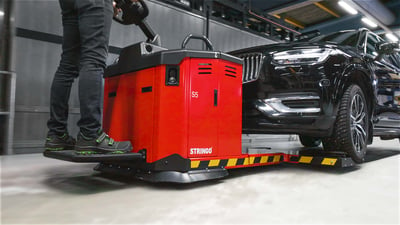“It’s all about efficiency,” says Tomas Holmgren, System Design Engineer in Stringo’s R&D department.
“Reducing manual steps during the assembly process saves time and money, for example when moving cars between workstations, or from the end of line.”
Tradition and technology: united for the future
The increased automation of the automotive sector also impacts how vehicle movers are used by manufacturers and other industry players. Tomas explains how Stringo’s upgraded product platform, released in 2024, responds to these demands:
“With the upgrade, our machines are prepared for AGV and automation, as well as continued technological innovations within AI and swarm networks.”
The platform’s open CAN bus architecture enables the vehicle mover’s control system to be connected to external software systems, opening up nearly limitless possibilities in today’s high-tech production environments.
“We don’t lock our customers into one software ecosystem. Instead, we make sure they can operate their Stringo within the automation systems they’re already using, for example for trucks or smaller mobile robots. Since there's no one standard protocol, this flexibility allows us to work with mobile robotic commissioning companies as well as end customers,” says Tomas.
Automation + omnidirection = maximum flexibility
Combined with steer-by-wire technology that reduces the turning angle and enables omnidirection manoeuvring, the vehicle movers on Stringo’s upgraded product platform offer maximum flexibility—including remote control operation with extreme precision:
“This is particularly useful in situations that require very precise positioning of the vehicle, such as wind tunnels for climate testing, or ADAS calibration (advanced driver-assistance systems),” Tomas explains.
Cost-efficient operations in non-traditional factories
Automation and high-precision manoeuvrability can also boost efficiency in smaller, non-traditional production facilities, Tomas continues:
“Setting up a production line with conveyor belts that manage 90 or 180 degree turns is a costly process. Letting an automated vehicle mover transfer the car from one conveyor belt to the next is a lot more flexible and cost-effective.”
Remote controlled or autonomous vehicle movers are used far beyond busy factory environments. For example, in collaboration with Safelog, a German AGV company, Stringo has developed a machine designed for operation in “flying carpet mode”.
“It offers an elegant way to present cars in a showroom setting, or during a high-end customisation process, where the buyer of an exclusive car can watch live as the final touches are added,” says Tomas.
Examples from the automation roadmap
Tomas shares a few examples of what he’s working with together with colleagues, customers, and partners:
“We’re looking at different options for wireless or inductive charging to enable continuous operation of autonomous vehicle movers. This would be valuable in factories with round the clock production.”
Another important focus area is figuring out the optimal placement of sensors and cameras to ensure a clear view around vehicles during autonomous transport.
“Safety remains the top priority at Stringo. We have to make sure the machines will be able to detect and stay clear of anyone or anything that might appear in its path,” Tomas concludes.
Want to learn more about vehicle mover innovations?
Read our article on how innovation drives safety, where Stringo’s CTO Magnus Grafström walks you through some recent product developments and how they contribute to a safer automotive manufacturing environment.





